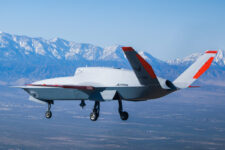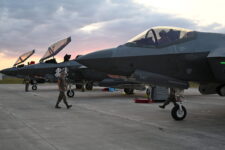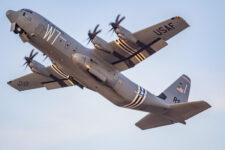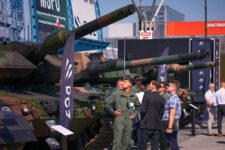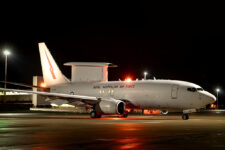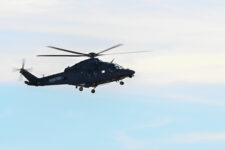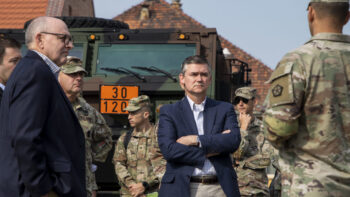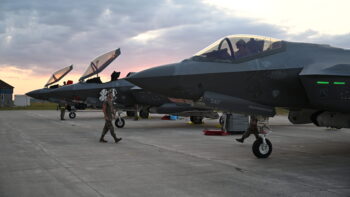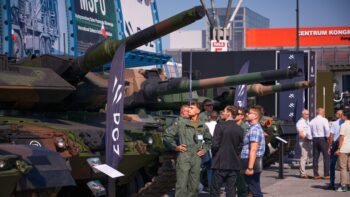
The GEK engine concept. (GE Aerospace image)
FARNBOROUGH 2024 — GE Aerospace and Kratos Defense & Security Solutions announced a new merchant supplier partnership today aiming to provide engines for, among others, the Air Force’s Collaborative Combat Aircraft (CCA) program — even as Kratos insists it is still open to bidding as a prime for the Air Force’s second CCA round.
Unveiled in a brief memorandum of understanding signing ceremony at the Farnborough air show today, GE Aerospace Defense and Systems President Amy Gowder said the family of “small, affordable” engines in development is starting out at around 800 pounds of thrust and could scale up to “probably just under” 3,000 pounds.
“We’re calling it GEK800, but it is a scalable architecture. So that’s ideally suited for cruise missiles,” Gowder said, adding that it could be scaled up for systems like drones and loitering munitions. “So as we see the requirements firm up, we’ll decide how high to scale or not. Certainly, there’s a lot of requirements that have not been disclosed on CCA due to the classified nature and the timelines there, so we will have more to say as requirements become more publicly disclosed,” she added.
RELATED: Air Force eyes thrust range targets for wingman drones, wants engine development to start in FY25
“The engines are almost complete,” said Kratos CEO Eric DeMarco. “These are real engines, and for competitive reasons, I’m not going to get into exactly where they’re at, but they’re just about ready to go, and we’ve already been in communications with customers. We understand what the first platforms will be, what the first systems will be, and we understand the competitive landscape from pricing and performance.
“We believe ours are better,” he added of the joint venture’s forthcoming “family” of powerplants.
The new partnership could complicate Kratos’s CCA ambitions, as a company executive previously told Breaking Defense that Kratos was aiming to become a prime contractor on the second round of the Air Force’s CCA program. Specifically, if Kratos intends to offer engines as a merchant supplier in partnership with GE, that would likely call for some kind of firewall between its CCA air vehicle and engine efforts — and still, other competitors may be hesitant to give a potential rival a perceived leg up.
When asked about the company’s previously stated prime contractor CCA ambitions, DeMarco then said, “I’m sure that was probably a few months ago. The game field — things change. So they may have changed, they may not have changed. We’ll see how that shakes out.”
DeMarco explained the company has a history of serving as a merchant supplier across programs, meaning that a product should be available to any customer.
“GEK is a merchant supplier of turbofans for a certain class of platform. That’s that part,” he said. “Kratos is a merchant supplier in engines. We’re a merchant supplier in hypersonic vehicles. We’re a merchant supplier in solid rocket motors. Then there’s the drones. We’re a merchant supplier in drones. But [from] time to time, we pick our spot, and we’ll prime when we believe the probability of win is high enough.”
In response to questions from Breaking Defense, a spokesperson for Kratos said the company “continues[s] to look at requirements as they are shared with industry” as it pertains to being a prime contractor for CCA. Additionally, the spokesperson said that since the engine development effort and unmanned systems like CCA are housed in separate divisions of the company, a firewall between the two efforts is “inherent.”
Asked about the lifespan of engines fielded through the new GEK partnership, Gowder replied by pointing to “affordable mass” when reasoning that the two manufacturers don’t require a “big tail of MRO,” or maintenance, repair and overhaul. Air Force officials have previously said that the CCA concept likely means the drones won’t have a long tail of maintenance typical for traditional platforms like large aircraft.
“We need something that can go one-way or two-way, but for limited cycles,” she added. “Clearly as requirements continue to become more and more clear, we’ll narrow in on exactly what that is, what would a maintenance concept be. It’s clearly going to be something that could be in the field, low cost.”
